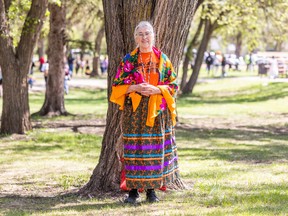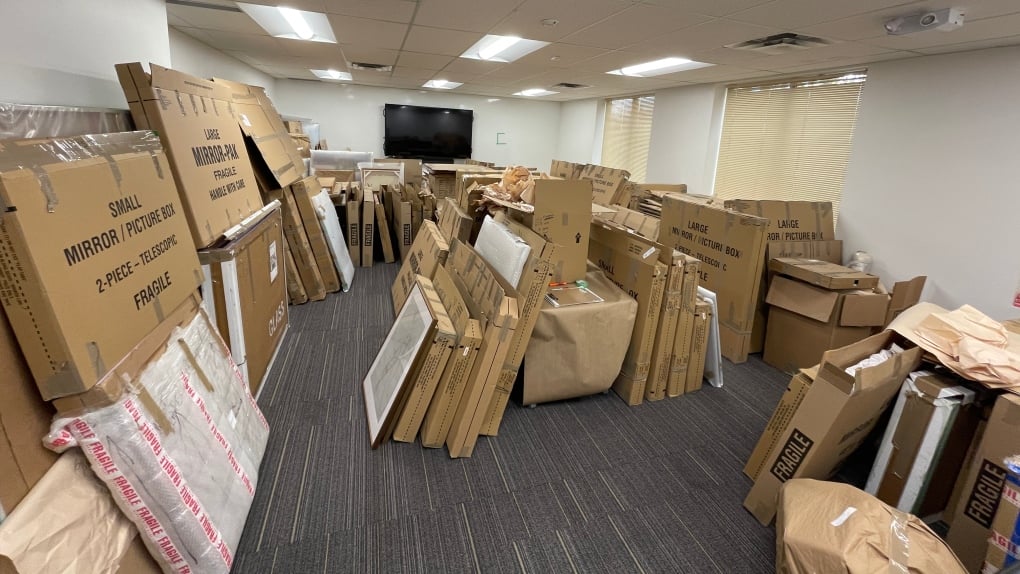When she was a little girl, Marjorie Beaucage’s grandmother taught her a lesson that would set her on a decades-long path of art, activism and social change.
Art
Two-spirit Elder Marjorie Beaucage shares stories from decades of art and activism

Those values led Beaucage to become a teacher, a community organizer, a filmmaker, an artist and a founder of Indigenous art spaces like the Aboriginal Film and Video Art Alliance.
Now in her 70s, Beaucage carries on her grandmother’s teachings as a two-spirit Métis Elder, serving as Elder for OUTSaskatoon, Elder-in-Residence for the University of Saskatchewan Students Union, and Grandmother for Walking With Our Sisters.
In her new book, ‘Leave some for the birds: Movements for justice,’ she shares stories and insights with the next generation of activists.
At first, she hadn’t intended to write a book — at a residency in New Mexico, she was exploring ideas for art projects using the journals she had kept from childhood through her 60s.
“Journaling was my survival when I was younger,” she said. “I had no place to put my feelings, and it was mostly anger and rage on those pages — but I didn’t want to carry it around. So it saved my life, really.”
“People were always asking me, ‘Are you writing your memoirs?’” she said. “And I said ‘No, memoirs are just lies you tell yourself about who you were.’ So I burnt them all, and I made a label for the jar of ashes — ‘Memoirs.’ But that jar wasn’t big enough. I had to go and buy a pail from Canadian Tire.”
Since then, Beaucage says she mostly left her journaling behind.
“I have a voice now,” she said. “I don’t need my journals in the same way.”
But even with the original pages gone, the ideas and lessons remained, and when she returned home, Beaucage decided to put them into a book: Not to tell stories about herself, but to offer a resource to others.
“There were some pretty good things I could pass on to future activists. And I didn’t realize there was so much poetry in my journals, either,” she says.
For two-spirit writer, speaker and advocate Prestin Thōtin-awāsis, “Marjorie came into my life when I needed her most.” He says Beaucage’s new book offers readers a chance to learn from her in a new way.
“What I love about this book is that I was able to open it to any page, and was able to read it and feel inspired with every poem and every sharing,” Thōtin-awāsis said. “Movements for justice, I think, is the true definition of Marjorie’s life.”
In revisiting her early writing, Beaucage saw how she had spent her life — “since the day I was born” — questioning everything.
In her book and in her conversations with young activists, Beaucage shares her hard-won lessons about balance — finding the right blend of action and reflection, which she wishes someone had been there to advise her on when she was younger.
“I burnt out so many times,” she said. “Everybody was ‘do, do, do.’ We were human doings, not human beings. And I wish somebody had said — sit down, have a cup of tea, slow down. It was a burning passion and I couldn’t quit. I remember sometimes, I was so 100 per cent ‘on it’ all the time that when I walked into a room, people didn’t want to make eye contact because they knew I was probably going to go into a rant. That wasn’t a good feeling.”
“That’s mostly where I balance myself out — picking berries, working on my garden, the water walks,” she said. “All those things help.”
And, fresh off her book launch, Beaucage seeks balance by continuing her water walk along the South Saskatchewan River.
This summer, she and a small group of water walkers will complete their three-year journey to walk and pray along the length of the river.
“It’s a ceremony for the water,” Beaucage explains. “When we go on pilgrimage or when we walk, we’re carrying the water to keep it flowing and keep it healthy — because the river is really sick, right now. It only has three feet of water in it. …
“It’s not a political act. It’s a ceremony. It’s not a protest. It’s helping the water get well. It’s just another expression of my love for the land.”
“It’s beautiful, being out there doing only one thing and being present in the moment all the time,” she said. “That’s the best part of it. Nothing else matters; just the water. We’re doing it for the water, and every step is a prayer.”

Art
A misspelled memorial to the Brontë sisters gets its dots back at last

LONDON (AP) — With a few daubs of a paintbrush, the Brontë sisters have got their dots back.
More than eight decades after it was installed, a memorial to the three 19th-century sibling novelists in London’s Westminster Abbey was amended Thursday to restore the diaereses – the two dots over the e in their surname.
The dots — which indicate that the name is pronounced “brontay” rather than “bront” — were omitted when the stone tablet commemorating Charlotte, Emily and Anne was erected in the abbey’s Poets’ Corner in October 1939, just after the outbreak of World War II.
They were restored after Brontë historian Sharon Wright, editor of the Brontë Society Gazette, raised the issue with Dean of Westminster David Hoyle. The abbey asked its stonemason to tap in the dots and its conservator to paint them.
“There’s no paper record for anyone complaining about this or mentioning this, so I just wanted to put it right, really,” Wright said. “These three Yorkshire women deserve their place here, but they also deserve to have their name spelled correctly.”
It’s believed the writers’ Irish father Patrick changed the spelling of his surname from Brunty or Prunty when he went to university in England.
Raised on the wild Yorkshire moors, all three sisters died before they were 40, leaving enduring novels including Charlotte’s “Jane Eyre,” Emily’s “Wuthering Heights” and Anne’s “The Tenant of Wildfell Hall.”
Rebecca Yorke, director of the Brontë Society, welcomed the restoration.
“As the Brontës and their work are loved and respected all over the world, it’s entirely appropriate that their name is spelled correctly on their memorial,” she said.
The Canadian Press. All rights reserved.
Art
Calvin Lucyshyn: Vancouver Island Art Dealer Faces Fraud Charges After Police Seize Millions in Artwork

In a case that has sent shockwaves through the Vancouver Island art community, a local art dealer has been charged with one count of fraud over $5,000. Calvin Lucyshyn, the former operator of the now-closed Winchester Galleries in Oak Bay, faces the charge after police seized hundreds of artworks, valued in the tens of millions of dollars, from various storage sites in the Greater Victoria area.
Alleged Fraud Scheme
Police allege that Lucyshyn had been taking valuable art from members of the public under the guise of appraising or consigning the pieces for sale, only to cut off all communication with the owners. This investigation began in April 2022, when police received a complaint from an individual who had provided four paintings to Lucyshyn, including three works by renowned British Columbia artist Emily Carr, and had not received any updates on their sale.
Further investigation by the Saanich Police Department revealed that this was not an isolated incident. Detectives found other alleged victims who had similar experiences with Winchester Galleries, leading police to execute search warrants at three separate storage locations across Greater Victoria.
Massive Seizure of Artworks
In what has become one of the largest art fraud investigations in recent Canadian history, authorities seized approximately 1,100 pieces of art, including more than 600 pieces from a storage site in Saanich, over 300 in Langford, and more than 100 in Oak Bay. Some of the more valuable pieces, according to police, were estimated to be worth $85,000 each.
Lucyshyn was arrested on April 21, 2022, but was later released from custody. In May 2024, a fraud charge was formally laid against him.
Artwork Returned, but Some Remain Unclaimed
In a statement released on Monday, the Saanich Police Department confirmed that 1,050 of the seized artworks have been returned to their rightful owners. However, several pieces remain unclaimed, and police continue their efforts to track down the owners of these works.
Court Proceedings Ongoing
The criminal charge against Lucyshyn has not yet been tested in court, and he has publicly stated his intention to defend himself against any pending allegations. His next court appearance is scheduled for September 10, 2024.
Impact on the Local Art Community
The news of Lucyshyn’s alleged fraud has deeply affected Vancouver Island’s art community, particularly collectors, galleries, and artists who may have been impacted by the gallery’s operations. With high-value pieces from artists like Emily Carr involved, the case underscores the vulnerabilities that can exist in art transactions.
For many art collectors, the investigation has raised concerns about the potential for fraud in the art world, particularly when it comes to dealing with private galleries and dealers. The seizure of such a vast collection of artworks has also led to questions about the management and oversight of valuable art pieces, as well as the importance of transparency and trust in the industry.
As the case continues to unfold in court, it will likely serve as a cautionary tale for collectors and galleries alike, highlighting the need for due diligence in the sale and appraisal of high-value artworks.
While much of the seized artwork has been returned, the full scale of the alleged fraud is still being unraveled. Lucyshyn’s upcoming court appearances will be closely watched, not only by the legal community but also by the wider art world, as it navigates the fallout from one of Canada’s most significant art fraud cases in recent memory.
Art collectors and individuals who believe they may have been affected by this case are encouraged to contact the Saanich Police Department to inquire about any unclaimed pieces. Additionally, the case serves as a reminder for anyone involved in high-value art transactions to work with reputable dealers and to keep thorough documentation of all transactions.
As with any investment, whether in art or other ventures, it is crucial to be cautious and informed. Art fraud can devastate personal collections and finances, but by taking steps to verify authenticity, provenance, and the reputation of dealers, collectors can help safeguard their valuable pieces.
Art
Ukrainian sells art in Essex while stuck in a warzone – BBC.com
[unable to retrieve full-text content]
Ukrainian sells art in Essex while stuck in a warzone BBC.com

Source link
-

 Sports17 hours ago
Sports17 hours agoIn The Rings: Curling Canada still looking for Canadian Curling Trials title sponsor
-

 Politics18 hours ago
Politics18 hours agoN.B. election debate: Tory leader forced to defend record on gender policy, housing
-

 News17 hours ago
News17 hours agoAfter hurricane, with no running water, residents organize to meet a basic need
-

 News17 hours ago
News17 hours agoAlberta government shifts continuing care from Health to Seniors Ministry
-

 News17 hours ago
News17 hours agoBuhai, Green and Shin lead in South Korea after 8-under 64s in first round
-

 News17 hours ago
News17 hours agoManitoba government halts school building plan, says other methods will be found
-

 Sports17 hours ago
Sports17 hours agoMaple Leafs winger Bobby McMann finding game after opening-night scratch
-

 News17 hours ago
News17 hours ago‘Significant overreach’: Ontario municipalities slam province over bike lane rules





















